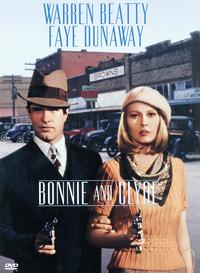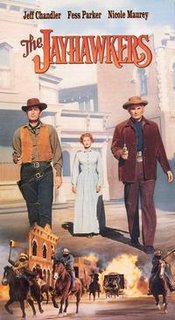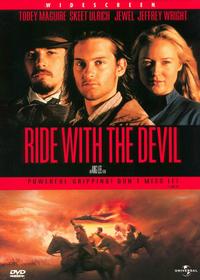Ballads of the Midwest
 Badlands
BadlandsPN1997 .B2452 1992
"He wanted to die with me and I dreamed of being lost forever in his arms." A young couple goes on a Midwest crime spree in Terrence Malick's hypnotically assured debut feature, based on the 1950s Starkweather-Fugate murders. Fancying himself a rebel like James Dean, twentysomething Kit (Martin Sheen) takes off with teen baton-twirler Holly (Sissy Spacek) after shooting her father (Warren Oates) when he tries to split the pair up. Once bounty hunters discover their riverside hiding place, Kit and Holly head towards Saskatchewan, leaving dead bodies in their wake. As the Law closes in, however, Holly gives herself up -- but Kit doesn't hold it against her, as he basks in his new status as a momentary folk hero. Inaugurating the use of voiceover narration that he would continue in Days of Heaven (1978) and The Thin Red Line (1998), Malick juxtaposes Holly's flat readings of her flowery romance novel diary prose with the banal and surreal details of their journey. Singularly inarticulate with each other, Kit and Holly are more intrigued by mythic celebrity gestures, as Holly peruses her fan magazines and Kit commemorates key moments before orchestrating a properly dramatic capture for himself (complete with the right hat). The sublime visuals lend a dreamlike beauty to the couple's trip even as their actions are treated casually; Malick neither glamorizes Kit and Holly nor consigns them to the bloody end of their fame-fixated predecessors in Bonnie and Clyde (1967). With the couple's opaque dialogue and Holly's fanzine dream narration, Malick further denies an easy explanation for their crimes. Made for under $500,000, Badlands debuted at the 1973 New York Film Festival, along with Martin Scorsese's Mean Streets, and was released within months of two other outlaw couple road movies, Steven Spielberg's The Sugarland Express and Robert Altman's Thieves Like Us. Although Badlands did not make an impression at the box office, its pictorial splendor and cool yet disquieting narrative established Malick as one of the most compelling artists to come out of early '70s Hollywood. ~Lucia Bozzola, All Movie Guide

Producer/star Warren Beatty had to convince Warner Bros. to finance this film, which went on to become the studio's second-highest grosser. It also caused major controversy by redefining violence in cinema and casting its criminal protagonists as sympathetic anti-heroes. Based loosely on the true exploits of Clyde Barrow and Bonnie Parker during the 30s, the film begins as Clyde (Beatty) tries to steal the car of Bonnie Parker (Faye Dunaway)'s mother. Bonnie is excited by Clyde's outlaw demeanor, and he further stimulates her by robbing a store in her presence. Clyde steals a car, with Bonnie in tow, and their legendary crime spree begins. The two move from town to town, pulling off small heists, until they join up with Clyde's brother Buck (Gene Hackman), his shrill wife Blanche (Estelle Parsons), and a slow-witted gas station attendant named C.W. Moss (Michael J. Pollard). The new gang robs a bank and Clyde is soon painted in the press as a Depression-era Robin Hood when he allows one bank customer to hold onto his money. Soon the police are on the gang's trail and they are constantly on the run, even kidnapping a Texas Ranger (Denver Pyle) and setting him adrift on a raft, handcuffed, after he spits in Bonnie's face when she kisses him. That same ranger leads a later raid on the gang that leaves Buck dying, Blanche captured, and both Clyde and Bonnie injured. The ever-loyal C.W. takes them to his father's house. C.W.'s father disaproves his son's affiliation with gangsters and enters a plea bargain with the Texas Rangers. A trap is set that ends in one of the bloodiest death scenes in cinematic history. The film made stars out of Beatty and Dunaway, and it also featured the screen debut of Gene Wilder as a mortician briefly captured by the gang. Its portrayal of Bonnie and Clyde as rebels who empathized with the poor working folks of the 1930s struck a chord with the counterculture of the 1960s and helped generate a new, young audience for American movies that carried over into Hollywood's renewal of the 1970s. Its combination of sex and violence with dynamic stars, social relevance, a traditional Hollywood genre, and an appeal to hip young audiences set the pace for many American movies to come. ~Don Kaye, All Movie Guide
Watch the trailer:
Director Arthur Penn talks about the film:
The Grapes of Wrath
PN1997 .G73 1996
Watch the trailer:
Director Arthur Penn talks about the film:
The Grapes of Wrath
PN1997 .G73 1996
The adaptation of Nobel Prize-winner John Steinbeck's Pulitzer Prize-winning novel of dirt-poor Dust Bowl migrants by 4-time Oscar-winning director John Ford starred Henry Fonda as Tom Joad, who opens the movie returning to his Oklahoma home after serving jail time for manslaughter. En route, Tom meets family friend Casey (John Carradine), a former preacher who warns Tom that dust storms, crop failures, and new agricultural methods have financially decimated the once prosperous Oklahoma farmland. Upon returning to his family farm, Tom is greeted by his mother (Oscar-winner Jane Darwell), who tells him that the family is packing up for the "promised land" of California. Warned that they shouldn't expect a warm welcome in California--they've already seen the caravan of dispirited farmers, heading back home after striking out at finding work--the Joads push on all the same. Their first stop is a wretched migrant camp, full of starving children and surrounded by armed guards. Further down the road, the Joads drive into an idyllic government camp, with clean lodging, indoor plumbing, and a self-governing clientele. When Tom ultimately bids goodbye to his mother, who asks him where he'll go, he delivers the film's most famous speech: "I'll be all around...Wherever there's a fight so hungry people can eat...Whenever there's a cop beating a guy, I'll be there...And when the people are eatin' the stuff they raise and livin' in the houses they build. I'll be there too." ~Hal Erickson, All Movie Guide
Watch the trailer:
 The Jayhawkers
The Jayhawkers
PN1997 .J394 1991
Set in the Kansas territory during the middle of the 19th century, this is a visually evocative but conventional western. The story deals with Darcy (Jeff Chandler), a ruthless man, one of the raiders known as "Jayhawkers" who wants more than what life is willing to offer. Starting out as anti-slavery activists, the Jayhawkers' origins are barely mentioned in the story, as Darcy uses them to support his growing power. Opposing his unscrupulous bid for control of the region is Cam (Fess Parker, of Davy Crockett fame on American TV) an ex-convict. Cam knows that Darcy is responsible for the death of his wife while he was in prison and he plans to bring him down. ~Eleanor Mannikka, All Movie Guide
The Learning Tree
PS3566.A73 L42 1987
Filmed in Fort Scott
Watch the trailer:
 The Jayhawkers
The JayhawkersPN1997 .J394 1991
Set in the Kansas territory during the middle of the 19th century, this is a visually evocative but conventional western. The story deals with Darcy (Jeff Chandler), a ruthless man, one of the raiders known as "Jayhawkers" who wants more than what life is willing to offer. Starting out as anti-slavery activists, the Jayhawkers' origins are barely mentioned in the story, as Darcy uses them to support his growing power. Opposing his unscrupulous bid for control of the region is Cam (Fess Parker, of Davy Crockett fame on American TV) an ex-convict. Cam knows that Darcy is responsible for the death of his wife while he was in prison and he plans to bring him down. ~Eleanor Mannikka, All Movie Guide
The Learning Tree
PS3566.A73 L42 1987
Filmed in Fort Scott
Gordon Parks' adaptation of his own novel The Learning Tree stars Kyle Johnson as Newt, a black teenager living in 1920s Kansas. He is an intelligent even-tempered young man who meets the many racial prejudices he faces with composure and pride. His best friend Marcus (Alex Clarke) is hot-headed and prone to react emotionally when confronted with life's problems. Newt gets into a difficult situation when he witnesses a murder and must decide if he should come forward to clear the man being framed for the crime. Doing so would forever change his own life, as well as Marcus'. In 1989, the film was selected to the National Film Registry in the Library of Congress. ~Perry Seibert, All Movie Guide
A dramatic comedy about life in the African-American community in the late 1960s, Ninth Street take place in Junction City, Kansas, a town that in 1968 looked to the nearby Fort Riley Army base for most of its economic support. Junction City's Ninth Street was home to a string of black-owned bars, clubs and strip joints, and the film follows a crew of Ninth Street regulars, including a tart-tongued nightclub owner (Queen Bey), a pair of philosophical winos (Don Washington and Kevin Willmott), a widowed and emotionally troubled bag lady (Kaycee Moore) and a young prostitute eager to get out of the life (Nadine Griffith). Shot on a shoestring budget over a period of seven years, Ninth Street features a cameo appearance from Martin Sheen as a priest who tends a flock in the ghetto, and a supporting performance from soul music legendIsaac Hayes, who also contributes to the score. ~Mark Deming, All Movie Guide
Picnic
PN1997 .P53 1989
Filmed in Hutchinson, Halstead, Salina, and Sterling
One of the biggest box-office attractions of the 1950s, Picnic was adapted by Daniel Taradash from the Pulitzer Prize-winning William Inge play. William Holden plays Hal Carter, a handsome drifter who ambles into a small Kansas town during the Labor Day celebration to look up old college chum Alan (Cliff Robertson, in his film debut). Hoping to hit up Alan for a job--or a handout--Hal ends up stealing his buddy's fiancee Madge Owens (Kim Novak). Hal also has a catnip effect on spinster schoolteacher Rosemary Sydney (Rosalind Russell), so much so that Rosemary makes a fool of herself in front of the whole town, nearly driving away her longtime beau Howard Bevans (Arthur O'Connell). Persuaded by his friends and family that Hal is no damn good, Madge is prepared to break off her relationship. As anyone who remembers the film's famous overhead closing shot knows, however, Madge is ultimately ruled by her heart and not her head. For a film set in Kansas, there's an awful lot of New York talent in the supporting cast (Susan Strasberg and Phyllis Newman come immediately to mind); still, the Midwestern ambience comes through loud and clear, especially during the perceptively detailed Labor Day picnic sequence. Broadening the film's appeal is its George Duning-Steve Allen title song, a variation of the old standard "Moonglow". Two sidebars: The original Broadway production of Picnic starred Ralph Meeker and Paul Newman; for the film version of Picnic, William Holden was obliged to shave his chest, lest his hairy torso cause the female moviegoers to conjure up impure thoughts. ~Hal Erickson, All Movie Guide
Watch the trailer:
 Ride with the Devil
Ride with the Devil
PN1997 .R53 2000
Filmed in Doniphan, Leavenworth, Miami, and Ellis Counties and Kansas City, MO
A complex tale of uneasy alliances along the Kansas/Missouri border during the Civil War, Ride with the Devil concerns Jack Bull Chiles (Skeet Ulrich), a proud son of the South ready to fight for the Confederate cause after his father is killed by Union troops. Chiles's best friend, Jake Roedel (Tobey Maguire), joins the Bushwhackers, a group of renegade Southerners aligned with the Confederate Army, even though his family supports the Union cause. The two young men, used to the slow pace and gracious lifestyle of the South's privileged class, are soon confronted with the chaos of battle. Their comrades include valiant leader Black John (James Caviezel), paranoid madman Pitt (Jonathan Rhys Myers), Southern gentleman George (Simon Baker), and Daniel (Jeffrey Wright), a slave from George's plantation. The Bushwhackers hide out in a barn near the home of Sue Lee (singer/songwriter/poet Jewel, in her film debut), a pregnant widow whose husband died in battle three weeks after their marriage. Roedel and Sue Lee begin a chaste romance, but it remains to be seen if the war will permit them to stay together. Adapted from the novel Woe to Live On by Daniel Woodrell, Ride with the Devil was directed by Ang Lee, whose previous project was a very different look at America's past, the 1970s domestic drama The Ice Storm (1997). ~Mark Deming, All Movie Guide
Sarah, Plain and Tall
PN1997 .S28 1998
Filmed in Lyndon and Topeka
The made-for-television film Sarah, Plain & Tall is a Hallmark Hall of Fame production about a single New England schoolteacher (Glenn Close) who responds to an advertisement by a Midwestern widower (Christopher Walken), who is asking for a bride to help him raise his two children. ~Stephen Thomas Erlewine, All Movie Guide
PN1997 .N5231 1999
Filmed in Topeka and Kansas City, MO
Filmed in Topeka and Kansas City, MO
A dramatic comedy about life in the African-American community in the late 1960s, Ninth Street take place in Junction City, Kansas, a town that in 1968 looked to the nearby Fort Riley Army base for most of its economic support. Junction City's Ninth Street was home to a string of black-owned bars, clubs and strip joints, and the film follows a crew of Ninth Street regulars, including a tart-tongued nightclub owner (Queen Bey), a pair of philosophical winos (Don Washington and Kevin Willmott), a widowed and emotionally troubled bag lady (Kaycee Moore) and a young prostitute eager to get out of the life (Nadine Griffith). Shot on a shoestring budget over a period of seven years, Ninth Street features a cameo appearance from Martin Sheen as a priest who tends a flock in the ghetto, and a supporting performance from soul music legendIsaac Hayes, who also contributes to the score. ~Mark Deming, All Movie Guide
Picnic
PN1997 .P53 1989
Filmed in Hutchinson, Halstead, Salina, and Sterling
One of the biggest box-office attractions of the 1950s, Picnic was adapted by Daniel Taradash from the Pulitzer Prize-winning William Inge play. William Holden plays Hal Carter, a handsome drifter who ambles into a small Kansas town during the Labor Day celebration to look up old college chum Alan (Cliff Robertson, in his film debut). Hoping to hit up Alan for a job--or a handout--Hal ends up stealing his buddy's fiancee Madge Owens (Kim Novak). Hal also has a catnip effect on spinster schoolteacher Rosemary Sydney (Rosalind Russell), so much so that Rosemary makes a fool of herself in front of the whole town, nearly driving away her longtime beau Howard Bevans (Arthur O'Connell). Persuaded by his friends and family that Hal is no damn good, Madge is prepared to break off her relationship. As anyone who remembers the film's famous overhead closing shot knows, however, Madge is ultimately ruled by her heart and not her head. For a film set in Kansas, there's an awful lot of New York talent in the supporting cast (Susan Strasberg and Phyllis Newman come immediately to mind); still, the Midwestern ambience comes through loud and clear, especially during the perceptively detailed Labor Day picnic sequence. Broadening the film's appeal is its George Duning-Steve Allen title song, a variation of the old standard "Moonglow". Two sidebars: The original Broadway production of Picnic starred Ralph Meeker and Paul Newman; for the film version of Picnic, William Holden was obliged to shave his chest, lest his hairy torso cause the female moviegoers to conjure up impure thoughts. ~Hal Erickson, All Movie Guide
Watch the trailer:
 Ride with the Devil
Ride with the DevilPN1997 .R53 2000
Filmed in Doniphan, Leavenworth, Miami, and Ellis Counties and Kansas City, MO
A complex tale of uneasy alliances along the Kansas/Missouri border during the Civil War, Ride with the Devil concerns Jack Bull Chiles (Skeet Ulrich), a proud son of the South ready to fight for the Confederate cause after his father is killed by Union troops. Chiles's best friend, Jake Roedel (Tobey Maguire), joins the Bushwhackers, a group of renegade Southerners aligned with the Confederate Army, even though his family supports the Union cause. The two young men, used to the slow pace and gracious lifestyle of the South's privileged class, are soon confronted with the chaos of battle. Their comrades include valiant leader Black John (James Caviezel), paranoid madman Pitt (Jonathan Rhys Myers), Southern gentleman George (Simon Baker), and Daniel (Jeffrey Wright), a slave from George's plantation. The Bushwhackers hide out in a barn near the home of Sue Lee (singer/songwriter/poet Jewel, in her film debut), a pregnant widow whose husband died in battle three weeks after their marriage. Roedel and Sue Lee begin a chaste romance, but it remains to be seen if the war will permit them to stay together. Adapted from the novel Woe to Live On by Daniel Woodrell, Ride with the Devil was directed by Ang Lee, whose previous project was a very different look at America's past, the 1970s domestic drama The Ice Storm (1997). ~Mark Deming, All Movie Guide
Sarah, Plain and Tall
PN1997 .S28 1998
Filmed in Lyndon and Topeka
The made-for-television film Sarah, Plain & Tall is a Hallmark Hall of Fame production about a single New England schoolteacher (Glenn Close) who responds to an advertisement by a Midwestern widower (Christopher Walken), who is asking for a bride to help him raise his two children. ~Stephen Thomas Erlewine, All Movie Guide
I couldn't find any excerpts from Sarah, Plain and Tall, but I couldn't pass up a chance to include a Christopher Walken clip. Here's his monologue from Pulp Fiction:

0 Comments:
Post a Comment
<< Home